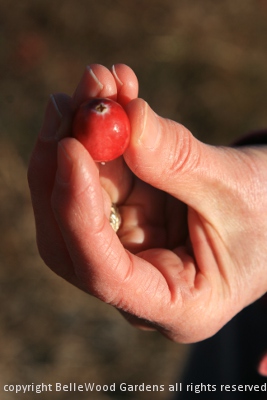
Sunday, 4 November 2012
Native Harvest: Cranberries

As with all good stories that begin "Once upon a time . . . . " this one started not yesterday but a few months ago, in July, when the Tohickon Garden Club had a meeting at Aquascapes. I asked Randy Heffner, the owner who is also a friend of mine, if he knew anyone with a cranberry bog where I might go and photograph the harvest. But of course he did. Gave me a telephone number. I called and left a perhaps somewhat confusing message. Go a reply. We spoke, and I was asked to call back in September. Then October. We settled on October 27 but then superstorm Sandy was on track to overrun New Jersey. Come if I wanted to, I was told, but be there really early on Saturday morning as after that the water levels in the bogs would be lowered in preparation for the weather event. As it turned out the cranberry bogs were unaffected and my visit the following weekend was on a Sunday of brilliant sunshine and fabulous harvest.
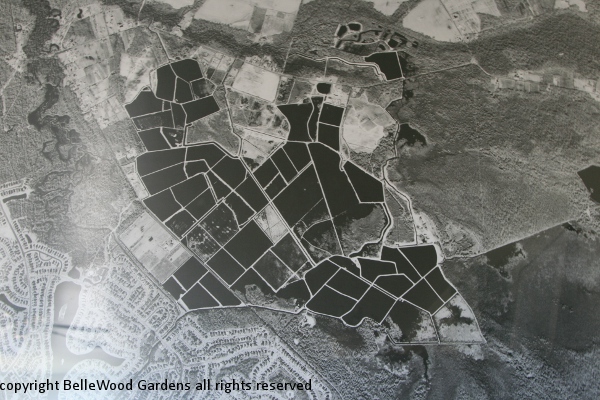
No dinkey little puddle of a bog. T.H. Budd & Sons have 1,200 acres of which 365 acres are in production.
The Budd family began cranberry farming five generations ago, when Tom Budd's great great grandfather planted his first cranberry vines in 1859, before the civil war, and organized the first formal meeting of cranberry farmers in 1864 prior to its end. Today the farm is one of the top cranberry producers in the state of New Jersey.

Tom Budd, fifth generation in his family's cranberry farming business.
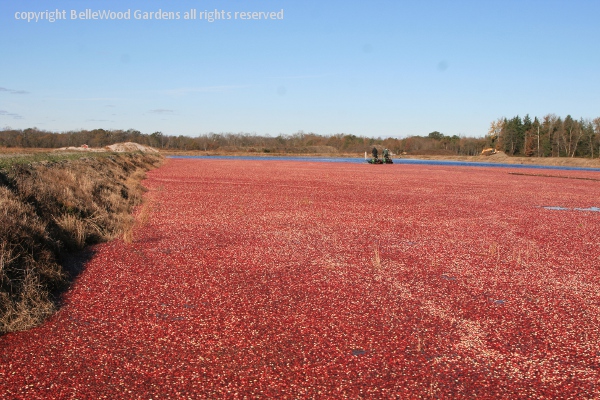
It's the end of the harvest season, and this, Tom told me, is one of his best bogs. No fooling!
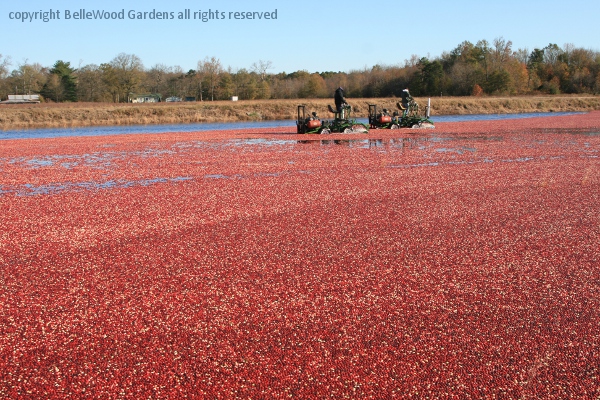
There are two ways to harvest cranberries: dry harvest where the berries are scooped off the vines with
scoops that have fingerlike extensions (very laborious according to Tom) and wet harvest from flooded bogs.
As an aside, let me assure you that water management is a major activity in commercial cranberry production.
Cranberries are not aquatic plants, like water lilies. A to-be-harvested bog is flooded the previous day.
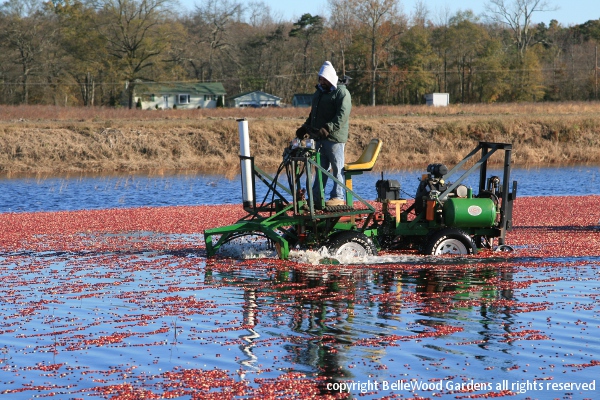
Equipment with fat tires and a snorkel for the engine drive into the bog. Reel-type beaters at
the front of the machine rotate, sending waves of water that knock the ripe berries loose from
vines flooded under about 18 inches of water. The berries then float up to the surface.
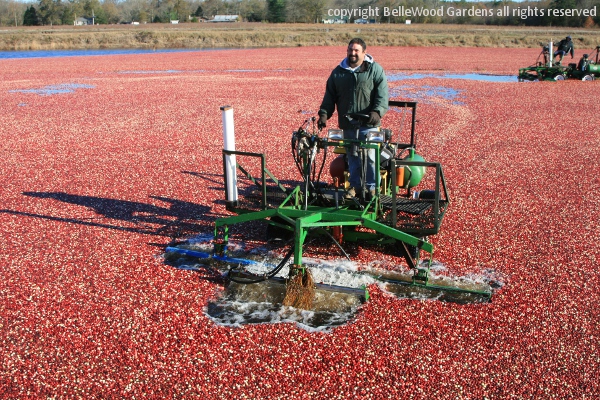
.
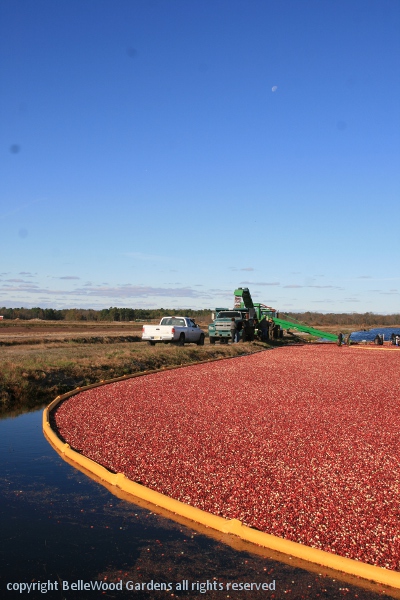
Next, the floating berries are corralled with booms that bring them
close to a dike where they can be loaded into huge dump trucks.
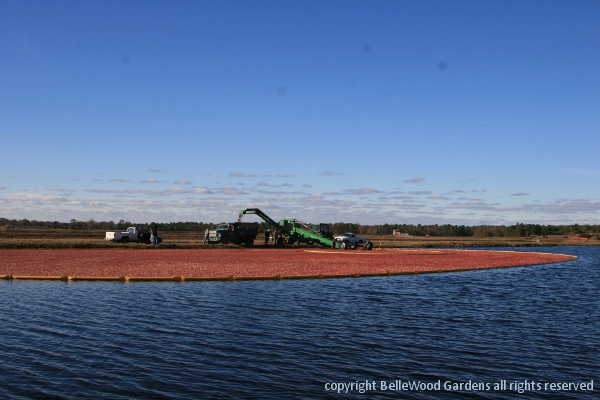
.
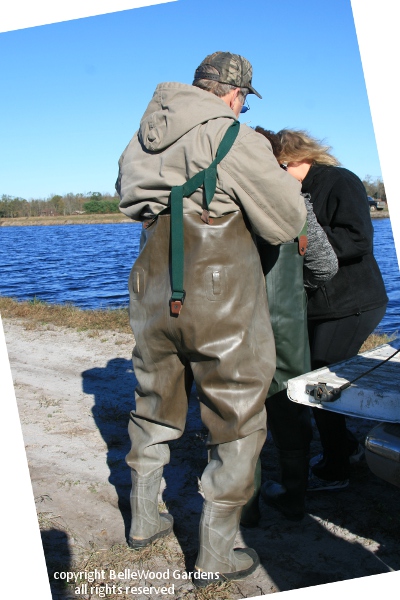
It's wet work. Boots won't do, you need to climb into chest-high waders.
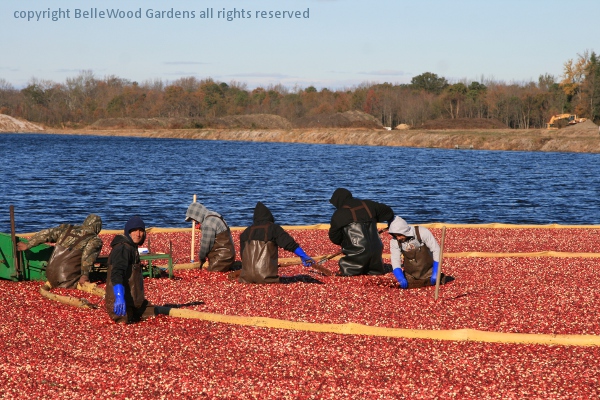
The cranberries are pushed to the intake mechanism. This is hard work, walking through knee-deep
water. And it's chilly, standing for a long time in the water at this time of year. Not like picking peaches.
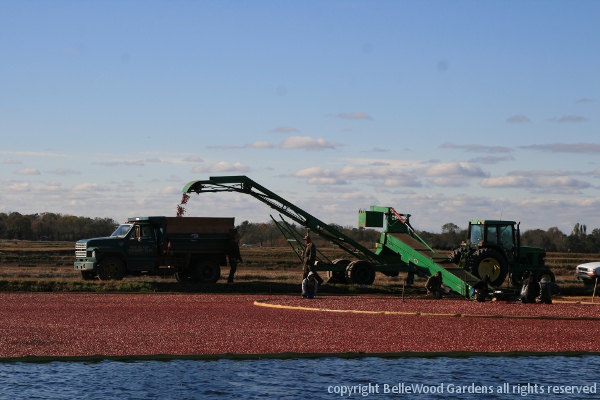
Wet harvest cranberries, sturdy though the berries are, are often used for juice, jam or relish.
A conveyor belt carries the berries up and sends them to the discharge chute. Bits of vine
fall down to the ground under the pickup chute while water is sent right back into the bog.
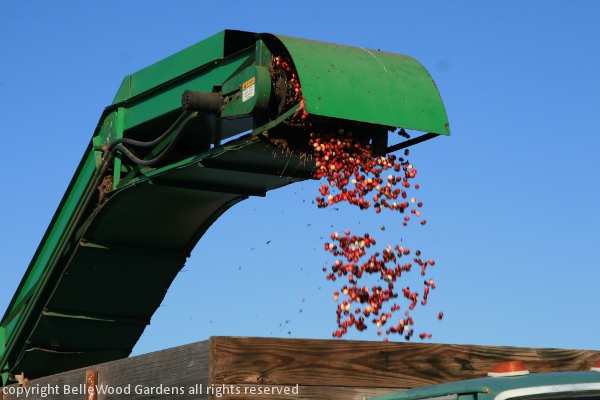
It doesn't take long to fill a truck and send it to the huge barn building across the road from the bogs.
As soon as one is filled another truck pulls up to collect its glistening load.
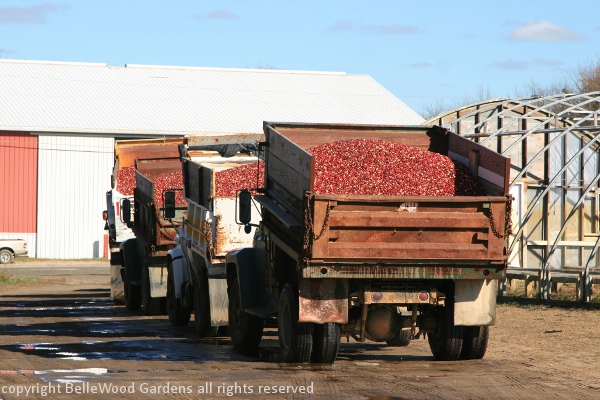
These big trucks belong to growers such as Pine Island Cranberry Company
who, like T. H. Budd and Sons, are all members of the Ocean Spray Cranberry Cooperative.
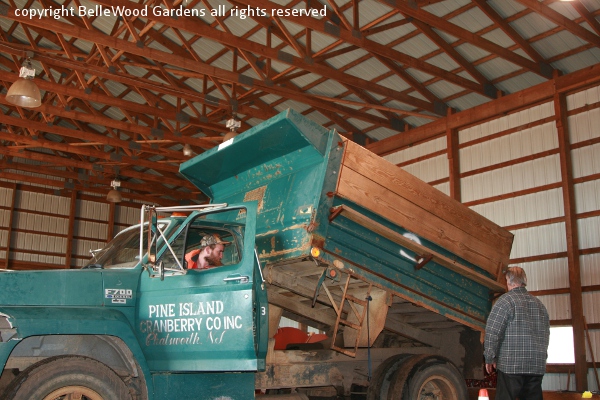
The cranberries are dumped into a huge tank-like vat.
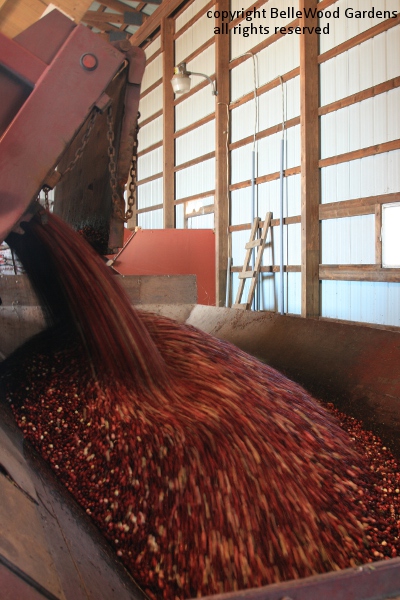 . . . .
. . . . 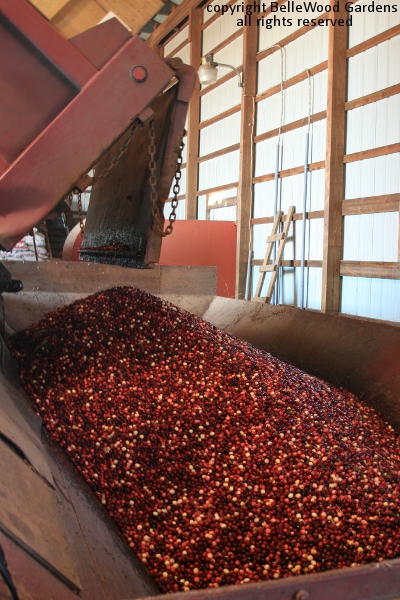
.
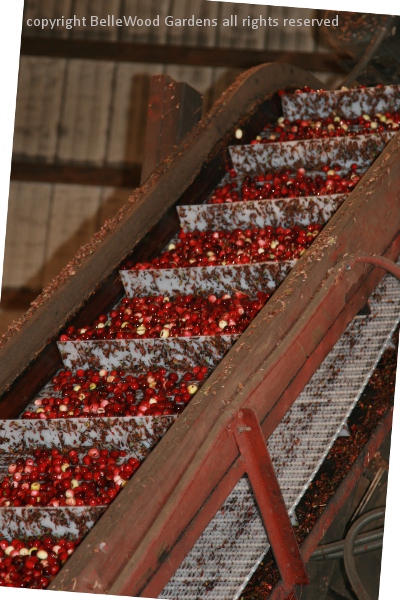
From there they go up another conveyor, debris falling through and also collecting on the shelves
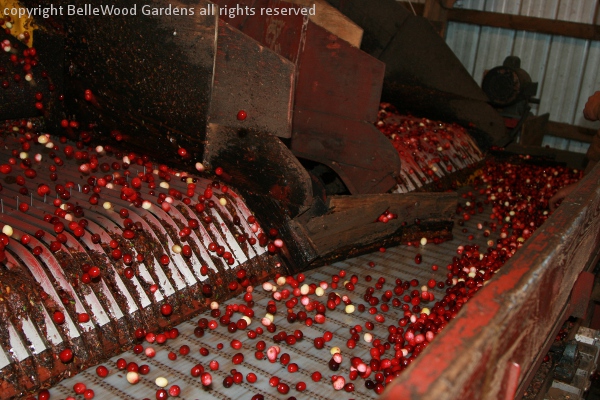
and out the other end, more bits of cranberry leaves and vines separated out in the process.
I was giggling, watching cranberries hopping in the air. Good bounce to a fresh cranberry.
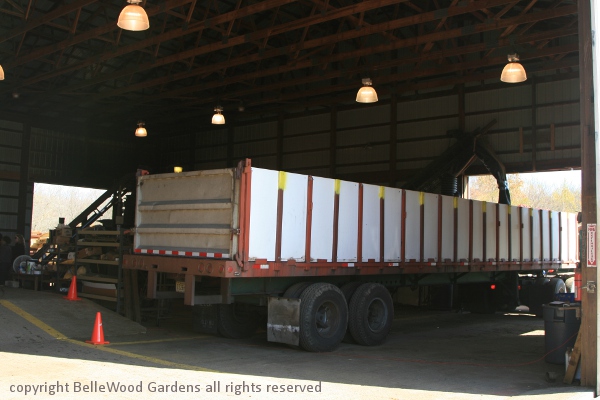
What's next? Well, there's this 18-wheeler tractor-trailer
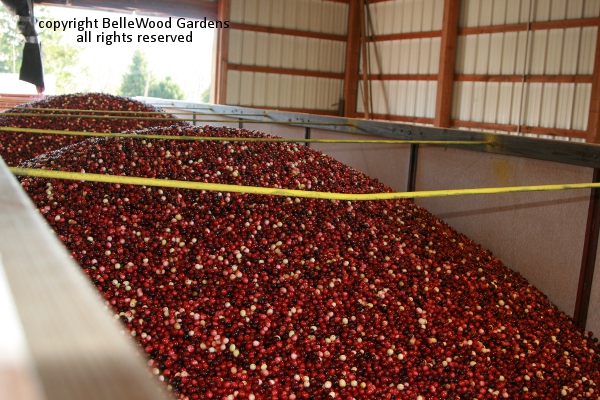
and they're filling it with cranberries. Eight big dump trucks fill one tractor-trailer.
Last year, 2011, T.H. Budd and Sons filled 180 tractor-trailers with their cranberries.
That's almost a thousand of the dump trucks I thought were so impressive, at first.

Here's Sue, Tom's sister, with a 5-gallon bucket of cranberries.
That's a lot, if you're only familiar with the grocery store 12-ounce bags.
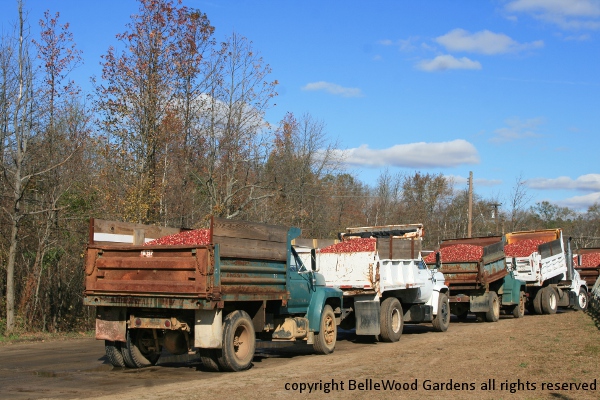
I've been here all morning and the trucks are still patiently lining up, waiting to unload.
Ocean Spray has a processing facility in Chatsworth, where the berries will be cleaned and
frozen. From there they will go to Bordentown, to be processed into juice and other products.
Alas, next year that plant will close as a new-from-the-ground-up facility opens in Pennsylvania.
This year's cranberry harvest may be nearly done. Not so Tom Budd's work. Ditches, dikes, and pumps all need to be checked, cleaned, and repaired as necessary. It takes four years before a newly planted bog - started from vine sections that need careful attention to establish the plants - begins to bear. After that, with careful tending, the vines will produce almost indefinitely, a hundred years or more. He likes to sand each bog on a five year rotation - spreading a layer of sand over the cranberry vines to help them root down, staying vigorous and healthy. In the spring there are sleepless nights as the vines come into flower. If a frost threatens someone must flood the bogs to protect the flowers, then drain them as the temperature rises the next morning. Hives of honeybees are brought in to ensure reliable and thorough pollination. And on, and on. So this year as you sit down to your Thanksgiving dinner give thanks to Tom Budd and all the other cranberry growers who bring us the ruby red native harvest of cranberries that add relish to our tables.
